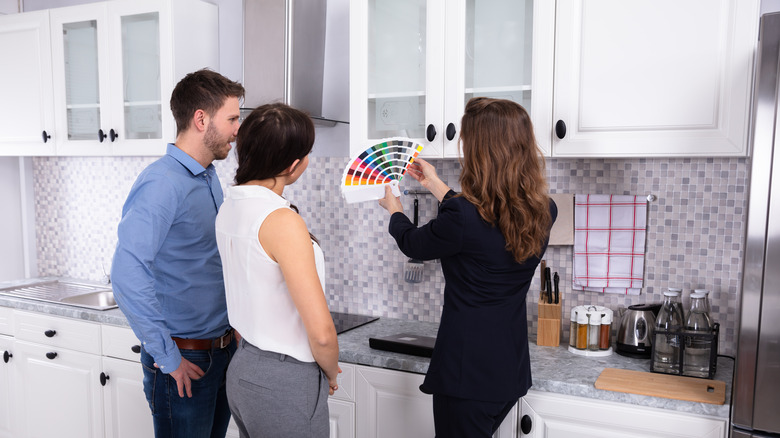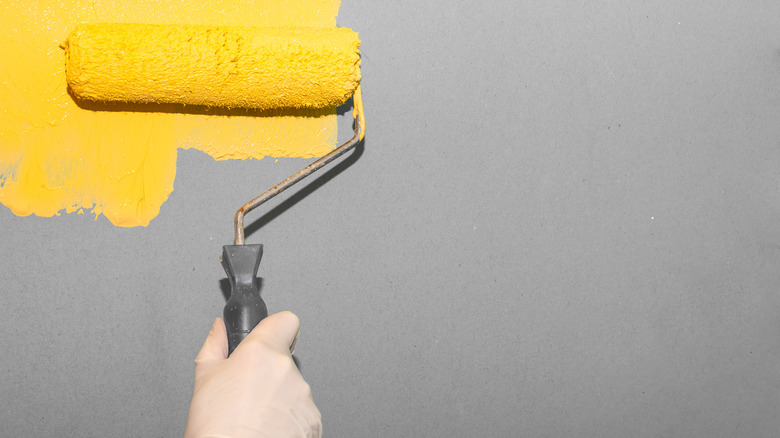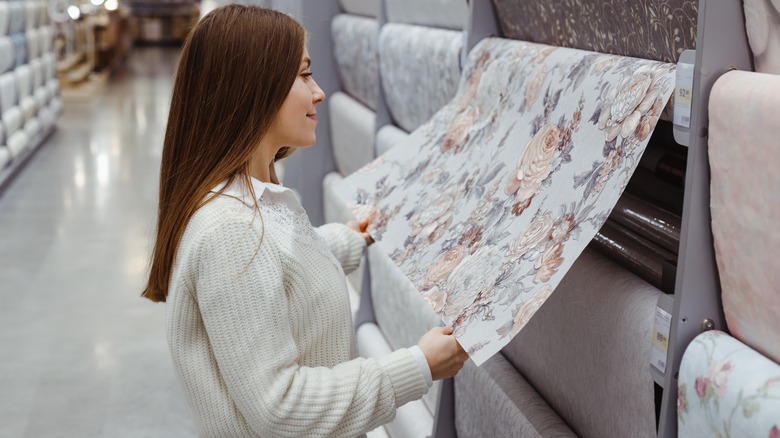Painting Inside Your Kitchen Cabinets Can Give A Subtle Pop Of Color
While large appliances such as your refrigerator or oven are often considered the focal point of many kitchens, the kitchen cabinets themselves typically have one of the biggest impacts on a space's overall look and feel. There's almost nothing that will date a kitchen faster than cabinets which were the popular style decades ago.
Replacing cabinets altogether can be fairly costly, coming in at anywhere from $2,000 to upwards of $10,000, depending on how large your kitchen is and what materials you're using. And, trying to attain a new look by refacing them isn't much more budget-friendly, with the price running hundreds per linear foot for the materials alone, not to mention installation costs.
If you're looking for a way to refresh your kitchen cabinets, you absolutely need to consider painting them — it's a budget-friendly and DIY-friendly solution. Plus, there are virtually endless shades of paint, so you can get exactly the look you want. However, if you tend to favor a neutral aesthetic in your space, it may feel like too big a plunge to transform the entirety of your wood or white cabinets with a bold hue. In that case, you may want to consider painting just the interior for a pop of color that's a lot more subtle. As a bonus, imperfections aren't as visible as they are on the cabinets' exterior, so it's a much easier task to DIY.
Tips for a perfect paint job
Painting your cabinet interiors is a great way to make a huge visual statement without overwhelming a room, so take a risk and select a bolder color than you ordinarily would. A can or two of paint isn't a huge expense, especially given the impact that splash of color will have on your kitchen. However, there is one major investment you'll have to make if you want the best possible results — time. In fact, it can often take twice as long to paint cabinet interiors as the exterior.
You still need to start by removing the doors and hardware to easily access the cabinet interior. Then comes the prep work — thoroughly clean your cabinets to ensure you have a good surface for the paint to stick to. You may even need to sand them if your cabinet interiors have a sheen to them.
All the corners, nooks, and crannies you need to deal with also make the job a lot more challenging. A spray painter can help you get a really smooth, even finish and may be worth purchasing or renting. If you're determined to complete the task with just your regular rollers and paint brushes, you'll want to invest in some angled brushes and other tools that help you get into those corners without overloading them with paint. Finally, as with painting any surface, doing multiple thin coats is key for reducing drips and obtaining even coverage.
Other ways to add a splash of color
Most people will paint the entirety of their cabinets' interior to get that statement-making burst of color. There are no rules to what you can or cannot do, so consider all possible options before getting started.
For example, you may want to just paint the back while leaving the shelves and sides the original hue, creating almost a backsplash for all your stunning dishware. If you want to incorporate a bit of pattern and color, you could swap your paint for some wallpaper or contact paper, adding some visual interest to the back of each cabinet. Alternatively, for an easier task where you don't need to deal with all the corners and tough-to-reach spots, you might consider removing the cabinet doors and just painting the interior of those — you'll still get a subtle pop of color when opening your cabinet, but you don't have to worry about your chosen shade clashing with your dishware.
Finally, if you're looking for an incredibly subtle whisper of color (and a very easy DIY project), you might want to splash your chosen shade only along the edges of each shelf — it keeps the overall effect neutral while still adding a bit of flair. For a renter-friendly option, swap out the paint for some washi tape, which can easily be applied to the edge of each shelf and removed when necessary.



